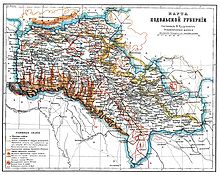Podolia Governorate
The governorate of Podolia ( Russian Подольская губерния / Podolskaja gubernija ) was located in the southwest of the Russian Empire in the general governorate of Kiev and was bordered by the governorates of Volhynia , Kiev , Cherson and Bessarabia and the Austrian crown lands of Galicia and Bukovina . Nowadays it belongs almost entirely to Ukraine (especially Vinnytsia Oblast and Khmelnyzkyj Oblast ), only a few corners north of the Dniester belong to the Republic of Moldova ( Transnistria ).
The governorate covered 42,017 km². The capital was Kamenets-Podolski (ukr. Kamjanez-Podilskyj ), from 1914 Vinnitsa (ukr. Vinnyzja ). It was divided into twelve circles ( Ujesdy ):
- Balta
- Brazlaw
- Gajsin ( Ukrainian Hajssyn )
- Jampol (ukr. Jampil )
- Kamenets-Podolski
- Letichev (Ukrainian Letychiv )
- Litin ( Ukrainian Lityn )
- Mogilew-Podolski (Ukrainian Mohyliw-Podilskyj )
- Novaya Uschiza ( Ukrainian Nova Uschyzja )
- Olgopoly ( Ukrainian Olhipil )
- Proskurow (today Khmelnyzkyj )
- Vinnitsa
The area came under the Polish partitions of 1793 and 1795 to the Russian Empire, the governorate was formed in 1796 from areas of the Podolia and Bracław voivodeships . It existed as an administrative unit until 1925.
statistics
In 1897 the governorate had 3,018,299 inhabitants, of whom 2,442,819 were Ukrainians, 98,984 Russians, 369,306 Jews, 69,156 Poles, 26,764 Romanians or Moldovans and 4,069 Germans.
The main line of business was agriculture. 63.5% of arable land, forest 14.7%, meadows 17% and non-land 4.8% of the area. The harvest in 1884 yielded: 3 million hectoliters of rye, 3 million hectoliters of wheat, 4 million hectoliters of oats, 1½ million hectoliters of barley, 1 million hectoliters of corn, 1 million hectoliters of potatoes; Buckwheat, peas, millet in smaller quantities. Melons, wine and tobacco were also extracted. In 1883 there were: 677,580 head of cattle, 807,458 sheep, 448,597 horses, 519,515 pigs, 17,912 goats. Podolia was famous for its oxen.
The value of industrial production was given in 1884 at 48,911,000 rubles; it took place in 1,616 factories with 24,083 workers. The main branches of industry were beet sugar production and refining (47 factories, 21,933,000 rub.), Brandy distillery (14,624,000 rub.) And grain milling (11 million rub.). The main trading centers were Kamenez-Podolski, Mogilew-Podolski and Balta.
literature
- Podolia . In: Meyers Konversations-Lexikon . 4th edition. Volume 13, Verlag des Bibliographisches Institut, Leipzig / Vienna 1885–1892, pp. 149–150.

